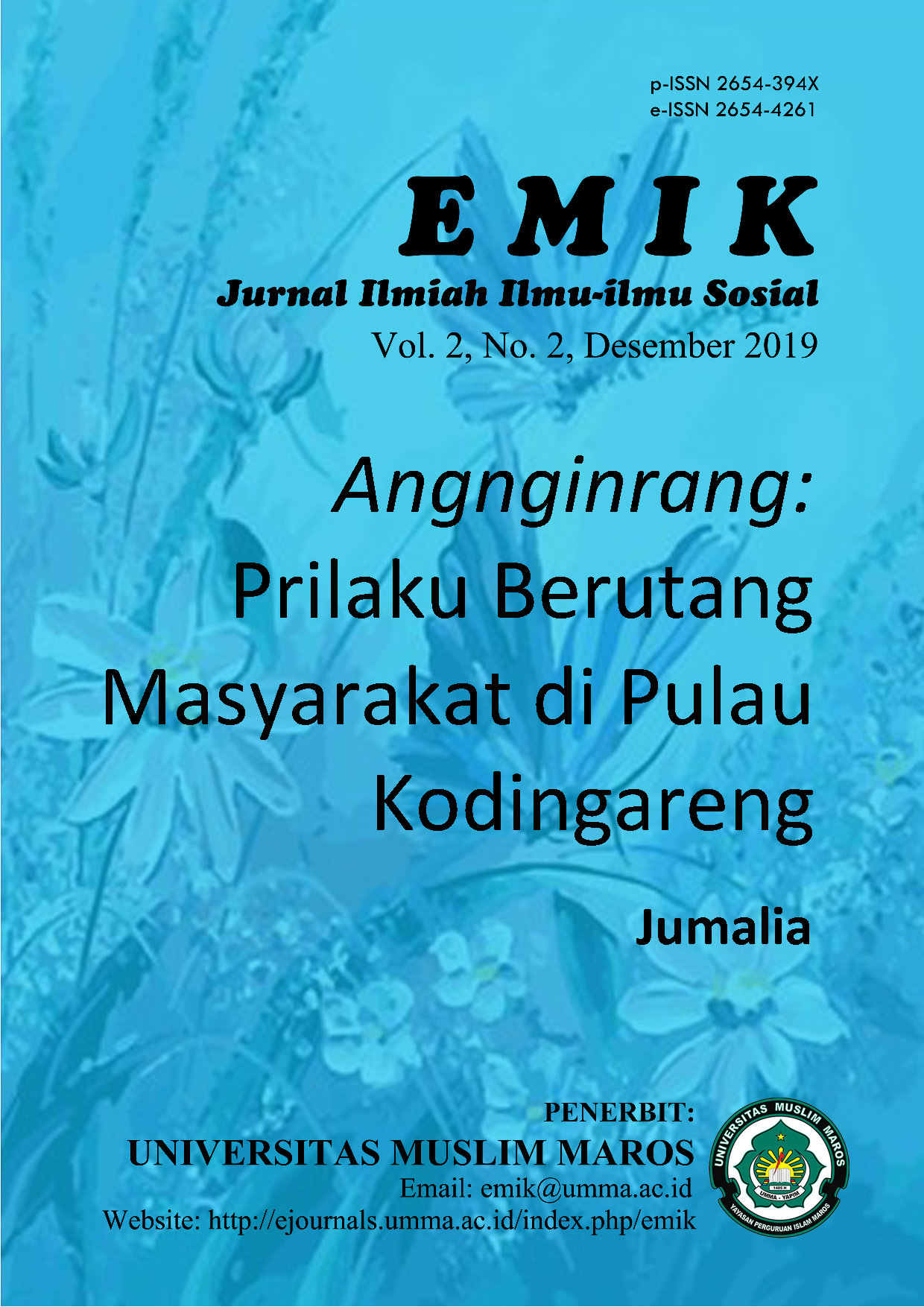Angnginrang
Prilaku Berutang Masyarakat di Pulau Kodingareng
Abstract
Human need is human desires to own and enjoy the usefulness of goods or services that can provide physical and spiritual satisfaction for survival. This study deals with the common social practice of debting at Kodingateng Island, Makassar. It examine the people’s perspective about debt, the debt mechanism, and the impact of debt in their social life.
This study was carried out at Kodingareng Island, Makassar, an island where debting is a common social practice. There were 11 participants involved in this study, consisting of a female college student, seven fishermen's wives, and a stall seller (pagadde-gadde), a diver (paselang), and a fisherman (papekang). They are aged between 24 and 47 years. Data was collected using in-depth interview (to explore people's perspectives on debt, debting mechanism, and the impact of debting behavior towards their life; and observation (to observe indebted transactions, who owes, what is owed, billing and payment moments).
The study shows that people at Kodingareng Island perceive debt (inrang) as a “habit” that has become a local tradition and debt as a “bond” between the lender (to appa'nginrang) and the borrower (to nginrang). The debt mechanism depends on debted needs, which are varied from primary needs, secondary needs, and tertiary needs; and on the importance of such need. The more important an item becomes, the more often the type of item is debted. The mechanism is simple, one just mention what s/he need and goods can be directly taken or delivered. Despite the fact there is a informal agreement between the lender and the borrower, in many cases the payment methods depends on the borrower. The impact of debt for the people of Kodingareng Island is categorized into three: people are trapped in an endless debt since debt is carried out continuously; generating generation debtors since they are accustomed to see and to practice debt; and affecting community social relations since payments are faltered, despite debting is not a shamefull behaviour.
References
Dahri, Harapandi. 2009. Tabot Jejak Cinta Keluarga Nabi Di Bengkulu. Jakarta: Citra.
Fatmawati, P. 2018. Etos Kerja Masyarakat Nelayan Di Kelurahan Cambayya Kecamatan Ujung Tanah Kota Makasssar. http://kebudayaan.kemdik-bud.go.id/bpnbsulssel-/2018/01/02/etos-kerja-masyarakat-nelayan-dikelu-rahan-cambaya-ujung-tanah-kota-makassar-fatmawati-p/, diakses tanggal 20 Januari 2018.
Fitch, C. 2007. “Debt And Mental Healt”. Journal Of Continuing Professional Development, The Role Of Psychiatrist Apt, 13: 194-202.
Halim, Abdul. 2005. Analisis Investasi. Edisi kedua. Jakarta: Salemba Empat.
Hamdat, Supriadi. 2010. Budaya Pangan Dan Gaya Hidup Keluarga Makassar. Jakarta: ASpublishing.
Heddy, Putra Ahimsa Shri. 1998. “MINAWANG” Hubungan Patron-Klien Di Sulawesi Selatan. Yogyakarta: Gadjah Mada University Press
Hidayat, Rahmat, dan Renanita, Theda. 2013. “Faktor-Faktor Psikologis Perilaku Berhutang Pada Karyawan Berpenghasilan Tetap”. Jurnal Psikologi, 40 (1): 92-101.
Johan. Muflikhati. Dan Mukhti. 2013. “Gaya Hidup, Manajemen Keuangan, Stategi Koping, Dan Kesejahteraan Keluarga Nelayan”. Jurnal Ilmu Keluarga Dan Konsumen Fakultas Ekologi Manusia IPB. Januari, 6 (1): 30-38.
Junida, Dwi Surti. 2012. Variasi Bentuk Pranata Sekuritas Sosial Pada Masyarakat Nelayan Di Pulau Kodingareng. Skripsi. Makassar: Departemen Antropologi, Universitas Hasanuddin.
Kamus Besar Bahasa Indonesia.1998. Jakarta: Pustaka Amani.
Kurniawan. 2015. Pengertian Anak Dari Berbagai perspektif. http://kurniawan-ramsen.blogspot.com/2015/02/pengertian--dari-berbagai-perspektif.html?m=1, diakses tanggal 27 Januari 2019.
Kusumawati, Peny. Rosyid, Abdul. Dan Kohar, Abdul. 2010. “Upaya Peningkatan Kinerja Usaha Perikanan Melalui Peningkatan Lingkungan Usaha Pada Alat Tangkap cantrang (Boat Seine) Dan Kebijakan Pemerintah Daerah Di Kabupaten Rembang”. Jurnal Saintek Perikanan. 6 (1). 36-45.
Mardimin, Johanes. 1994. Jangan Tangisi Tradisi. Yogyakarta: Kanisius.
Meleong, Lexy J. 2001. Metodologi Penelitian Kualitatif. Bandung: PT. Remaja Rosdakarya.
Monita, Dita. 2013. Sistem Pendukung Keputusan Penerima Bantuan Langsung Tunai Dengan Menggunakan Metode Analytical Hierarchy Process, Pelita Informatika Budhi Dharma, 3 (2): 2301-9425.
Morris, M. & Kaplinsky, Raphael. 2002. A Handbook For Value Chain Research, IDRC. Mccormick,D & Schmitz, H. 2001. Manual For Value Chain Researchon Homeworkes In The Garment Industry. www.ids.ac.uk/-ids/global/wiego.html.
Pusoro, Argo. 2015. Makalah Teori Humanistic Abraham Maslow. https://argopusoro.wordpress.com/2015/07/02/makalah-teori-huma-nistik-abraham-maslow/, diakses tanggal 17 Januari 2018.
Santrock, John W. Perkembangan Anak Jilid 1 Edisi Kesebelas. Jakarta : PT. Erlangga.
Shohib, Muhammad. 2015. “Sikap Terhadap Uang Dan Perilaku Berhutang”. Jurnal Ilmiah Psikologi Terapan. Januari, 03 (01): 132-143.
Strebkov, Denis. 2005. “Household Borrowing Behavior In Russia”. Problems Of Economic Transition. 48 (5): 22-48.
Soekanto, Soerjono. 2006. Sosiologi Suatu Pengantar. Jakarta: Rajawali Pers.
Winarno. 2014. Pengertian kebutuhan manusia. http://winarno99wins.-wordpress.com/2014/03/22/pengertian-kebutuhan-manusia/, diakses tanggal 18 Januari 2018.




